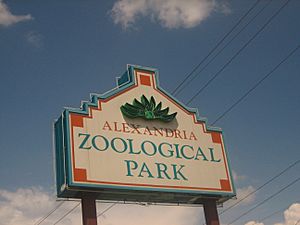Alexandria Zoological Park facts for kids

Entrance sign to the zoo
|
|
| Date opened | 1926 |
|---|---|
| Location | Alexandria, Louisiana |
| Land area | 33 acres (13 ha) |
| Coordinates | 31°17′16″N 92°27′27″W / 31.287642°N 92.457365°W |
| No. of animals | 500 |
| Memberships | AZA |
The Alexandria Zoological Park is a fun 33-acre (13 ha) zoo in Alexandria, Louisiana, USA. It first opened its doors in 1926. The City of Alexandria owns and runs the zoo. It is home to about 500 amazing animals.
The zoo started small, with just a few cages in Bringhurst Park. In the 1960s, the zoo almost closed. To save it, a group called Friends of the Alexandria Zoo (FOTAZ) was created. This group still helps the zoo today!
The Alexandria Zoo is officially recognized by the Association of Zoos and Aquariums (AZA). This means it meets high standards for animal care. The zoo also helps protect animals through about 20 Species Survival Plans (SSP).
Contents
A Look Back: Zoo History
The Alexandria Zoological Park began in 1926. In the early days, the animal homes were simple. They had chain link fences and metal bars. Not many plants grew near the exhibits back then.
Only the old fish pools from that time are still used today. Now, they are a home for wild birds. More animal homes, like a pool for sea lions, were added in the 1940s.
The zoo started with common pets like rabbits and deer. There are not many records from these early years. The zoo did not change much until the late 1960s. That is when it faced a possible closure.
This led to the creation of the first zoo committee. This group grew into the Friends of the Alexandria Zoo (FOTAZ). They are a big help to the zoo even now.
Much of the zoo's success is thanks to Robert Leslie Whitt. He was the zoo director for 34 years. He started working there in 1974.
Explore the Exhibits and Fun Areas
The zoo has many cool exhibits. It also has four special themed areas.
African Experience: Meet Animals from Africa
The zoo opened a part of its African Experience in 2003. Here, you can see African lions in a large, natural-looking home. It has big rocks and a waterfall.
This area also has dwarf crocodiles and crested porcupines. In 2004, two new exhibits opened here. One is for the zoo's giant Aldabra tortoises and Galapagos tortoises. The other is a "Venom Center" for African snakes.
Louisiana Habitat: Discover Local Wildlife
Louisiana Habitat opened in 1998. It shows off the plants, animals, and culture of Louisiana. You can see animals native to the state.
These include alligators, roseate spoonbills, and North American river otters. You might also spot cougars, black bears, and bobcats. Other animals are raccoons, red wolfs, and white-tailed deer.
These animals live in exhibits that look like their natural homes. You can see them in marshes, swamps, and uplands. There is even an underwater viewing area. Here, you can watch turtles, fish, otters, and alligators swim! This exhibit has won awards for being a great public space.
Bayou Le Zoo Choo Choo: All Aboard!
The Bayou Le Zoo Choo Choo is the zoo's miniature train. It is a narrow gauge train. It runs all year long.
In January and February, it only runs on weekends. It also runs during the zoo's Holiday Light Safari. The train station is near the main entrance. The train takes visitors on a ride around the edge of the zoo.
Special Events All Year Long
The zoo hosts fun events every year. These include:
- Zoo Boo at Halloween
- Holiday Light Safari
Helping Animals: Conservation Efforts
The zoo works hard to protect animals. It takes part in about 20 Species Survival Plans (SSP). These plans help save endangered animals.
Some of the animals in these plans include:
- Andean condors
- Chinese alligators
- clouded leopards
- colobus monkeys
- cotton-top tamarins
- fishing cats
- gibbons
- golden lion tamarins
- Indochinese tigers
- jaguars
- lions
- lion-tailed macaques
- Louisiana pine snakes
- maned wolfs
- ocelots
- red wolfs
- spectacled bears
- spider monkeys
- toucans
The zoo also has other animals that are threatened or endangered. These include African dwarf crocodiles and American crocodiles. You can also see Bengal tigers, black howler monkeys, and Brazilian tapirs. Other special animals are lowland anoas, Nile crocodiles, and Palawan peacock pheasants. Don't forget the red-handed tamarins and red kangaroos!
Throughout the year, the zoo holds special events to promote conservation. These include talks, Party for the Planet, and Wild Tie & Tennis Shoe Night. They also celebrate International Migratory Bird Day, Black Bear Awareness Day, and Endangered Species Day.
What's Next for the Zoo?
The African Experience exhibit will continue to grow. In the future, it will be home to many more animals. These will include zebras, giraffes, and pygmy hippos. You might also see hoofed mammals, birds, leopards, servals, and more colobus monkeys. Other future residents include meerkats and Nile crocodiles.
Images for kids


